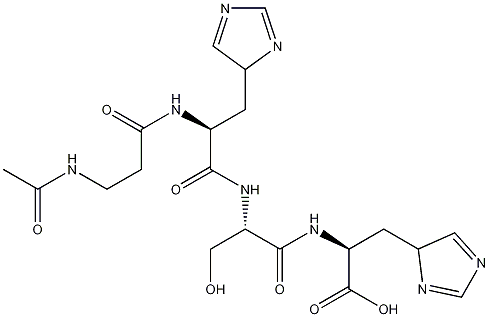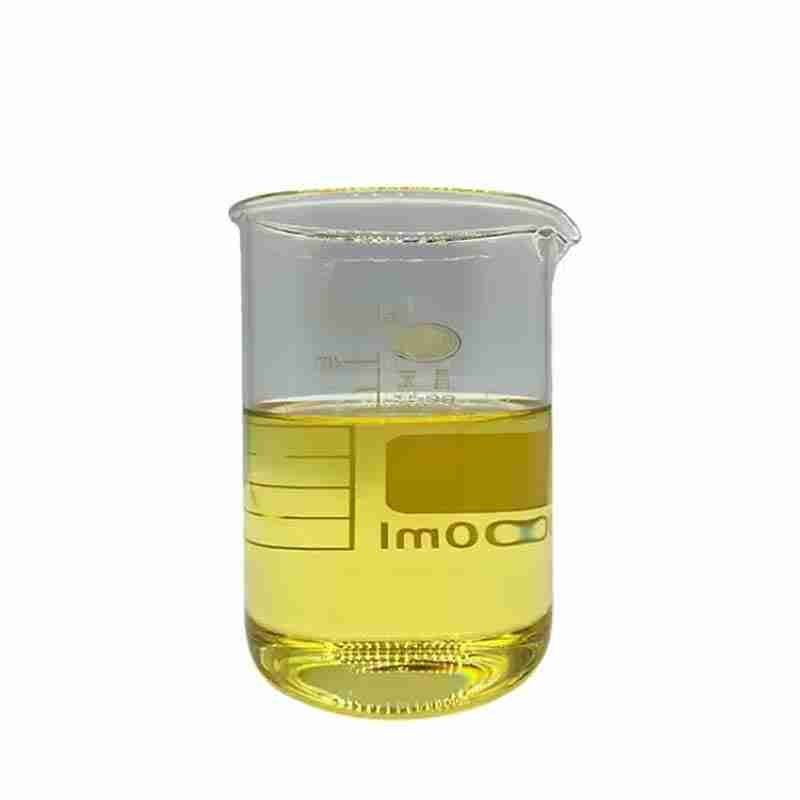Acetyl Tetrapeptide-5 CAS# 820959-17-9
Acetyl Tetrapeptide-5 is a white to cream coloured powder. The active ingredient is used to treat lachrymal sacs and dark circles under the eyes. It stimulates cell metabolism, improves skin elasticity, reduces puffiness and water retention in the eye area and makes the skin supple.Acetyl tetrapeptide-5 inhibits collagen glycation avoiding skin losing elasticity and subsequent eyebags formation .
Acetyl tetrapeptide-5 prevents liquid accumulation in eyebags .
Acetyl tetrapeptide-5 shows a slight lightening effect which decreases dark circles under the eyes Use level: 0.01 %, maximum 0.1 % (water soluble)
发送询盘
Acetyl Tetrapeptide-5 CAS# 820959-17-9
| Acetyl Tetrapeptide-5 Basic information |
| Product Name: | Acetyl Tetrapeptide-5 |
| Synonyms: | N-Acetyl-beta-alanyl-L-histidyl-L-seryl-L-histidine;Acetyl tetrapeptide-5;Acetyl Tetrapeptide;Depuffin/Acetyl Tetrapeptide-5;Acetyl Tetrapeptide-5/eyeseryl;Depuffin;tetrapeptide;Eyeseryl / Acetyl Tetrapeptide-5 |
| CAS: | 820959-17-9 |
| MF: | C20H28N8O7 |
| MW: | 492.49 |
| EINECS: | 1312995-182-4 |
| Product Categories: | BEAUTY PEPTIDES;APIs;820959-17-9 |
| Mol File: | 820959-17-9.mol |
 |
|
| Acetyl Tetrapeptide-5 Chemical Properties |
| Boiling point | 1237.3??65.0 ??C(Predicted) |
| density | 1.443 |
| storage temp. | 2-8??C |
| solubility | PBS (pH 7.2): 10 mg/ml |
| form | A crystalline solid |
| pka | 2.76??0.10(Predicted) |
| color | White to off-white |
| InChIKey | RIUMNDWYYDHBFO-UDJPXWLSNA-N |
| SMILES | C(O)(=O)[C@H](CC1N=CN=C1)NC(=O)[C@H](CO)NC(=O)[C@H](CC1N=CN=C1)NC(=O)CCNC(C)=O |&1:3,13,19,r| |
- 2
- 2-diallylpent-4-en-1-amine
- 4
- 95-16-9
- Ammonium sulfamate
- Benzothiazole
- cas:67889-00-3ح2
- cas:83524-75-8 | pigment black 32
- cas:928836-00-4 | 2
- cas:932745-70-5 | 4
- Chemical Minerals
- Coconut diethanolamide
- Daily Chemicals
- discount
- for sale
- General pvc resin
- hexyl D-glucoside
- in stock
- Lauramidopropyl betaine
- LAURIC ACID MONOETHANOLAMIDE
- Petroleum Additives
- Plasticiser
- Ploymers
- price
- PVC
- quotation
- Raw Materal
- Remove term: Petroleum Additives Petroleum Additive
- SODIUM ETHYL 2-SULFOLAURATE
Related Products
1-Octanol, also known as Capryl alcohol or n-Octanol, is a clear, colorless liquid with a characteristic waxy odor. It is an alcohol with eight carbon atoms in its chain, making it a part of the aliphatic alcohol family. This compound is poorly soluble in water but is miscible with ethanol, diethyl ether, and chloroform . It has a melting point of approximately -15??C and a boiling point of around 196??C . 1-Octanol is used in the production of esters, plasticizers, and as a solvent or intermediate in the synthesis of various organic compounds. It also finds application in the fragrance industry as a fixative in perfumes and can be used in the formulation of flavor and scent compositions . It is important to note that 1-Octanol is flammable and should be handled with care, storing it away from sources of ignition and heat .
Product name:Cyclopentane
Purity:96%
Appearance:White powder
Package:25kg/bag
Sample:Available
Terpene resin is a type of natural resin derived from terpenes, which are organic compounds found in various plants. It is known for its aromatic properties and is commonly used in the production of fragrances, flavorings, and as a component in adhesives and coatings within the chemical industry. Terpene resin offers a range of benefits, including enhancing the solubility of essential oils and providing a stable base for various applications. Its natural origin makes it a preferred choice for eco-friendly products.
Chemical Name: Zinc citrate
Synonyms: Zinc citrate trihydrate
CAS No.: 546-46-3
Molecular Formula: C6H8O7Zn
Molecular Weight: 257.5
Appearance: White powder
Chemical Name: Arabic gum
CAS No.: 9000-01-5
Appearance: powder
Chemical Name: Choline salicylate
CAS No.: 2016-36-6
Molecular Formula: C12H19NO4
Molecular Weight: 241.28
Appearance: Red-Brown Crystal
Polyhexamethylene guanidine hydrochloride, often abbreviated as PHMG-HCl, is a high molecular weight polymeric biguanide compound known for its potent antimicrobial properties. With a chemical structure that features a long chain of methylene groups bridged by guanidine units, PHMG-HCl is effective against a broad spectrum of microorganisms, including bacteria, viruses, and fungi.
This hydrochloride salt form of PHMG is highly soluble in water and is commonly used in various applications due to its non-irritant and non-toxic nature to human skin and mucous membranes. It is widely recognized for its ability to form a colorless and odorless solution, making it an ideal choice for use in personal care products, medical disinfectants, and water treatment processes.
The versatility of PHMG-HCl lies in its cationic nature, which allows it to bind to negatively charged microbial cell walls, disrupting their integrity and leading to cell death. This mechanism of action contributes to its effectiveness as a preservative and disinfectant. Moreover, its substantivity, or the ability to adhere to surfaces, enhances its long-lasting antimicrobial activity.
In summary, Polyhexamethylene guanidine hydrochloride is a reliable and efficient antimicrobial agent, pivotal in industries where hygiene and cleanliness are paramount, offering a safe and sustainable solution for microbial control.
Succinimide is a heterocyclic organic compound and an important industrial chemical. It serves as a key intermediate in the synthesis of various pharmaceuticals, agrochemicals, and other specialty chemicals. Known for its reactivity and versatility, succinimide is widely used in the production of succinic anhydride, a precursor to many polymers and plasticizers, highlighting its significance in the chemical industry.
Chemical Name: Ammonium Iron(II) Sulfate
Synonyms: Diammonium iron bis(sulphate); iron (ii) ammonium sulfate
CAS No.: 10045-89-3
Molecular Formula: FeH5NO4S
Molecular Weight: 170.95
Silicones are a family of synthetic polymers known for their versatility and stability. They are heat-resistant, non-toxic, and have excellent electrical insulation properties. Commonly used in various industries such as construction, automotive, aerospace, and personal care products, silicones offer a wide range of applications from sealants and adhesives to lubricants and medical devices. Their resistance to extreme temperatures and weathering makes them a preferred choice for many high-performance applications.
Chemical Name: UV-120
Other Name: (2’,4’-Di-tert-butylphenyl 3,5-di-tert-butyl-4-hydroxybenzoate)
CAS No.: 4221-80-1
Molecular Fomula: C29H42O3
Molecular weight: 438.66
Assay: ≥99%(LC)
Chemical Name: Potassium Castorate
CAS No.: 8013-05-6
Molecular Formula: C57H107K3O12
Molecular Weight: 1101.74718
Appearance: Yellow Liquid


















